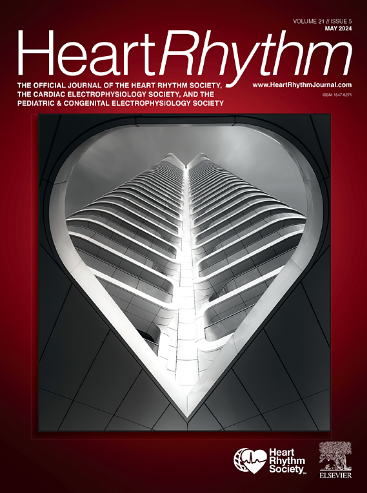Exploring SCN5A variants associated with atrial fibrillation in atrial cardiomyocytes derived from human induced pluripotent stem cells: A characterization study
IF 5.6
2区 医学
Q1 CARDIAC & CARDIOVASCULAR SYSTEMS
引用次数: 0
Abstract
Background
Atrial fibrillation (AF) poses a major risk for heart failure, myocardial infarction, and stroke. Several studies have linked SCN5A variants to AF, but their precise mechanistic contribution remains unclear. Human induced pluripotent stem cells (hiPSCs) provide a promising platform for modeling AF-linked SCN5A variants and their functional alterations.
Objective
The purpose of this study was to assess the electrophysiological impact of 3 AF-linked SCN5A variants (K1493R, M1875T, N1986K) identified in 3 unrelated individuals.
Methods
CRISPR-Cas9 was used to generate a new hiPSC line in which NaV1.5 was knocked out. Following differentiation into specific atrial cardiomyocyte by using retinoic acid, the adult wild-type (WT) and 3 AF variants were introduced into the NaV1.5 knockout (KO) line through transfection. Subsequent analysis including molecular biology, optical mapping, and electrophysiology were performed.
Results
The absence of NaV1.5 channels altered the expression of key cardiac genes. NaV1.5 KO atrial-like cardiomyocytes derived from human induced pluripotent stem cells displayed slower conduction velocities, altered action potential (AP) parameters, and impaired calcium transient propagation. The transfection of the WT channel restored sodium current density, AP characteristics and the expression of several cardiac genes. Among the AF variants, 1 induced a loss of function (N1986K) while the other 2 induced a gain of function in NaV1.5 channel activity. Cellular excitability alterations and early afterdepolarizations were observed in AF variants.
Conclusion
Our findings suggest that distinct alterations in NaV1.5 channel properties may trigger altered atrial excitability and arrhythmogenic activity in AF. Our KO model offers an innovative approach for investigating SCN5A variants in an adult human cardiac environment.
探索从 hiPSCs 中提取的心房心肌细胞中与心房颤动相关的 SCN5A 变异:特征研究
背景:心房颤动(房颤)是导致心力衰竭、心肌梗死和中风的主要风险因素。多项研究表明,SCN5A变体与心房颤动有关,但其确切的机理作用仍不清楚。人类诱导多能干细胞(hiPSCs)为模拟与 SCN5A 相关的房颤变异及其功能改变提供了一个前景广阔的平台:本研究的目的是评估在三个无关个体中发现的三个房颤相关SCN5A变异K1493R、M1875T和N1986K的电生理影响:方法:使用 CRISPR-Cas9 技术生成一种新的 hiPSC 株系,其中 NaV1.5 被敲除。在使用视黄酸分化成特异性心房心肌细胞后,通过转染将成人 WT 和 SCN5A 变体引入 NaV1.5 KO 株系。随后进行了分子生物学、光学绘图和电生理学等分析:结果:NaV1.5 通道的缺失改变了关键心脏基因的表达。NaV1.5 KO hiPSC-aCMs 的传导速度减慢,动作电位(AP)参数改变,钙离子瞬态传播受损。转染 WT 通道可恢复钠离子电流密度和 AP 特性。在AF变体中,一个诱导了功能缺失(N1986K),而另外两个诱导了NaV1.5通道活性的功能增益。在房颤变体中观察到了细胞兴奋性改变和早期后极化:我们的研究结果表明,NaV1.5 通道特性的不同改变可能会引发房颤时心房过度兴奋和致心律失常活动。我们的 KO 模型为研究人类心脏环境中的 SCN5A 变异提供了一种创新方法。
本文章由计算机程序翻译,如有差异,请以英文原文为准。
求助全文
约1分钟内获得全文
求助全文
来源期刊

Heart rhythm
医学-心血管系统
CiteScore
10.50
自引率
5.50%
发文量
1465
审稿时长
24 days
期刊介绍:
HeartRhythm, the official Journal of the Heart Rhythm Society and the Cardiac Electrophysiology Society, is a unique journal for fundamental discovery and clinical applicability.
HeartRhythm integrates the entire cardiac electrophysiology (EP) community from basic and clinical academic researchers, private practitioners, engineers, allied professionals, industry, and trainees, all of whom are vital and interdependent members of our EP community.
The Heart Rhythm Society is the international leader in science, education, and advocacy for cardiac arrhythmia professionals and patients, and the primary information resource on heart rhythm disorders. Its mission is to improve the care of patients by promoting research, education, and optimal health care policies and standards.
 求助内容:
求助内容: 应助结果提醒方式:
应助结果提醒方式:


